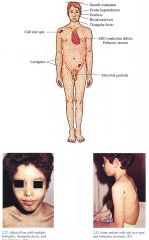![]()
![]()
![]()
Use LEFT and RIGHT arrow keys to navigate between flashcards;
Use UP and DOWN arrow keys to flip the card;
H to show hint;
A reads text to speech;
12 Cards in this Set
- Front
- Back
|
Clinical LEOPARD Syndrome
|

|
|
|
Synonym
|
Multiple Lentigines Syndrome
|
|
|
Inheritance
|
Autosomal dominant; PTPN11 gene on 12q24
|
|
|
Prenatal
|
DNA analysis if defect known
|
|
|
Incidence
|
Over 70 cases reported; M = F
|
|
|
Age at Presentation
|
Lentigines begin at birth or first few months of life; abundant by 4 to 5 years old
|
|
|
Pathogenesis
|
A mutation in PTPN11, a gene encoding the nonreceptor protein tyrosine phosphatase SHP2 and implicated in Noonan syndrome, has been isolated in nine patients evaluated with the LEOPARD phenotype.
|
|
|
Clinical
|
Skin
Generalized multiple Lentigines; mucous membranes spared CAFÉ noir spots Café au lait spots Cardiovascular Electrocardiographic (ECG) conduction defects Pulmonic stenosis, aortic stenosis, obstructive cardiornyopathy Craniofacial Ocular hypertelorism; Triangular facies Genitourinary Abnormal genitalia hypospadias, cryptorchiclism Musculoskeletal Growth Retardation; Pectus excavaturn or carinaturn Central Nervous System Sensorineural Deafness Mild mental retardation (rare) |
|
|
D/Dx
|
Carney Complex (p. 78) Peutz jeghers syndrome (p. 186) Noonan syndrome (p. 354) Premature aging and multiple nevi
|
|
|
Lab
|
Skin biopsy
|
|
|
Management
|
Thorough cutaneous examination by dermatologist Complete physical examination by primary care physician Referral to cardiologist, audiologist, urologist Evaluate first degree family member
|
|
|
Prognosis
|
Normal life span; pulmonic stenosis rarely disabling Speech difficulties secondary to deafness if not diagnosed early on
|

